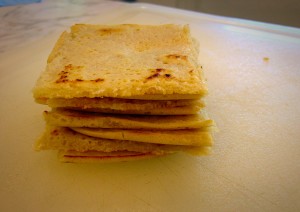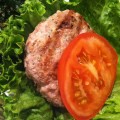
Lately, it seems like everyone is gluten free. It’s definitely hip to be gluten free.
“It’s healthier to avoid gluten” is a common perception nowadays. While having lunch with several gluten-free (by choice) friends the other day, I felt a little self-conscious ordering a sandwich. I mean, I’m supposed to be a healthy-food nut, and here I was savoring bread of all things. Instead of making excuses and defending my (apparently harmful) love of glutenous foods, I decided to look into the matter further.
What is Gluten?
Gluten is simply protein that is found in grains such as wheat, spelt, barley, and rye. Gluten is like a glue that holds foods together — it’s what gives French bread its divine chewiness and pasta its al dente bite. For people with celiac disease, eating gluten triggers the immune system to attack the small intestine, which can cause a bunch of health problems such as malnutrition, anemia, and even depression. There are also people who have symptoms of celiac disease — which include diarrhea, weight loss, headaches, and fatigue — but do not get positive blood test results; these people often have a gluten intolerance that is not celiac. Obviously, if you fall into one of these two categories, you should not eat gluten.
Is Gluten-Free a Healthier Choice?
For people who have to avoid gluten, the world is a much better place than it was just a few years ago. Gluten-free foods are everywhere. My grocery store has an entire gluten-free section, and even old school pizza joints offer gluten-free crusts (that don’t taste like cardboard). But, just because something is gluten free does not mean it’s a healthier choice for people without gluten intolerance or celiac. Whereas whole wheat flour is made from nothing but wheat, some gluten-free flour is highly processed and full of unpronounceable ingredients. Same with gluten-free cookies, crackers, and breads. Often they add things like xanthan gum to the flour to give it the right texture (xanthan gum, which is made from corn sugar that is fermented with a bacteria, is in gobs of processed foods), as well as lots of sugar and other flavoring agents to hide the weird (fake) taste. So, I would argue that for people who don’t have real health issues with eating gluten, going gluten free is not a healthier choice.
Should You Give Up Gluten?
All of that being said, Yes I think you should give up gluten. Huh? Aside from blood tests and endoscopy, the only way to know if you have a gluten intolerance is to forgo eating foods containing gluten for a few weeks. From what I’ve heard from my gluten-sensitive friends, the difference is remarkable and obvious after only three to four weeks off gluten. So, I do think it’s worth giving it a try. If you’re like me, the only thing you will feel after forgoing bread, pasta, and burritos for a month is slightly irritated. Maybe you will lose a few pounds, although I didn’t — there were still plenty of non-gluten grains (rice, corn, oats, buckwheat, quinoa, etc.) to keep my belly (and jeans) full. Potato chips are gluten free, so are tacos…
If you, like me, don’t notice a significant improvement in your health, I would go back to eating some gluten — just because there really isn’t any better vegetable & hummus–delivery system than a whole wheat flour tortilla, and a cold beer after skiing is way better than just about anything else. And because French bread. If gluten is not a problem for you, I think it’s unnecessarily restrictive to go gluten free — and not in any way healthier than eating modest amounts of healthy, minimally processed wheat (no, not Wonder Bread and Ritz crackers alas).
If, on the other hand, you notice an amazing difference (such as fewer stomach problems, less joint pain, better sleep), it may mean you are in fact gluten intolerant. At that point, I’d see a doctor and get tested for celiac disease. Because if you do have celiac disease, even minute amounts of gluten can make you sick. If you do go gluten free, look for high-quality baked goods (preferably organic) and flours. I’ve been almost able to pass off Tinkyada Brown Rice pasta as regular whole wheat pasta, and I’ve had good results with Cup 4 Cup Wholesome Flour, which is GMO free, as well as with experimenting with grain-free flours such as almond meal and tapioca starch.
Here’s my all-time favorite bread/cracker recipe for people who are avoiding gluten (or grains in general). This also makes a fantastic grain-free pizza crust, tostada, bruschetta, and hummus delivery system. Even though I do consume gluten, I still make this all the time. My daughter loves it with avocado mashed on it for breakfast.
 Grain-Free Flatbread
Grain-Free Flatbread
Ingredients
1 cup tapioca flour (also called tapioca starch)
1 cup almond flour (also called almond meal)
3/4 cup water
1/4 cup extra virgin olive oil
1/2 tsp. salt
1/4 tsp. baking soda
Stir together all ingredients in a bowl and mix until smooth (no lumps). Pour into a flat-bottom skillet or griddle that has been heated over medium-high heat. (I have an 11” square griddle pan that works perfectly, but you can also use a round skillet, just make sure there is a fairly large flat surface so the batter is not more than 1/4-1/3″ thick when you pour it in. I use a round cast iron skillet when I use this to make a pizza crust, which is awesome, by the way.) Cook until the bottom is browned and fairly hard. Carefully flip the bread in one piece and cook the other side on low heat until it’s cooked through. Remove from heat and cut into pieces with a large knife. Store in a plastic bag for 2-3 days.
I’d really be interested to hear your stories of giving up gluten and how that’s worked out for you.


Hi Bevin –
I’ve had gluten issues for years and suffer from migraines and sinus headaches nearly daily when I am eating wheat in my diet. When I go off of it, my head is clear and I live basically problem free both in my head and in my gut. Although I am addicted to bread, especially the baguette pictured below, once I go without gluten for a week and get through the shakes I live happy and feel like a totally new person, pain free and with much more energy. I’m currently in withdrawal mode as I’ve just re-committed again effective today March 1st! Wish me luck in my commitment for a gluten free, headache free, summer. Fresh Fruits and Veggies – here I come! Lori
Good luck! I know it’s hard for the first week or so, but it does get easier — and so much easier to handle when you know how much better it will make you feel! Definitely try this grain-free “bread” recipe; it’s really chewy and not weird I promise!